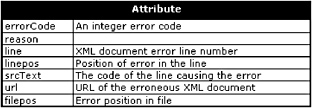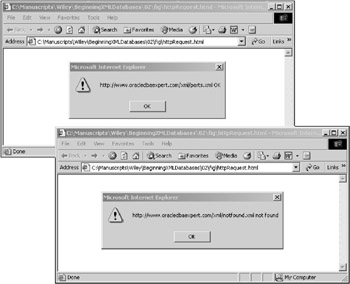More Obscure XML DOM Classes
| | ||
| | ||
| | ||
In this section you read about and experiment with non-structural and somewhat non-central XML DOM classes. Lets begin with the parseError class.
The parseError Class
The parseError class is exclusive to Microsoft and Internet Explorer. It can be used to get details of what an error is, should one have occurred, as an XML document is loaded and parsed in the browser. Figure 2-16 shows all the interesting attributes and methods for the parseError class.

Figure 2-16: The XML DOM parseError class can contain error details.
Here is an example XML document containing a very simple error. The start element <World> does not match the ending element <world> because the case of the two element names is different:
<?xml version="1.0"?> <WORLD> <countries> <country> <name>Canada</name> <states> <state> <name>Quebec</name> <cities> <city> <name>Montreal</name> <type>French</type> </city> </cities> </state> <state> <name>British Columbia</name> <cities> <city> <name>Vancouver</name> <type>Nice</type> </city> </cities> </state> </states> </country> <country> <name>United States</name> <states> <state> <name>New York</name> <cities> <city> <name>New York City</name> <type>Commercial</type> </city> <city> <name>Buffalo</name> <type>Big Snow Balls</type> </city> </cities> </state> <state> <name>California</name> <cities> <city> <name>San Francisco</name> <type>Silicon Valley</type> </city> <city> <name>Los Angeles</name> <type>Polluted</type> </city> <city> <name>San Diego</name> <type>Sunny</type> </city> </cities> </state> </states> </country> </countries> </world> In order to access information placed into a parseError object by the most recent error produced, the parseError class can be as in the following HTML and JavaScript code:
<HTML><BODY> <SCRIPT LANGUAGE="JavaScript"> var xmlDoc = new ActiveXObject("Microsoft.XMLDOM"); xmlDoc.async = false; xmlDoc.load("cities.xml"); document.write(xmlDoc.xml); if (xmlDoc.parseError.errorCode != 0) { document.writeln("Error " + xmlDoc.parseError.errorCode + " on line " + xmlDoc.parseError.line + ", position " + xmlDoc.parseError.linepos + "<BR><BR>"); document.writeln(xmlDoc.parseError.reason + "<BR><BR>"); document.writeln(xmlDoc.parseError.srcText + "<BR><BR>"); } </SCRIPT> </BODY></HTML> Setting the preceding async attribute to false ensures asynchronous download of the XML document. The entire document is parsed prior to executing the rest of this script.
The result is as shown in Figure 2-17 where in the first browser window (top-left of the diagram) the error is present in the cities.xml file, as shown previously. The second browser window (bottom-right of the diagram) has the error corrected, with both root elements set as <world> .
XML is case sensitive!

Figure 2-17: Using the parseError class
HTTPRequest Class
An HTTP request allows a web page to be changed without the page being reloaded in the clients browser. Attributes and methods for the HTTPRequest object are shown in Figure 2-18.

Figure 2-18: The XML DOM HTTPRequest class passes data between XML documents and the server.
This following example tests for a URL to see if it exists:
<HTML><BODY> <SCRIPT LANGUAGE="JavaScript"> var url = "http://www.oracledbaexpert.com/xml/parts.xml"; var xmlHTTP = new ActiveXObject("Microsoft.xmlHTTP"); xmlHTTP.open("HEAD", url, true); xmlHTTP.onreadystatechange = function() { if (xmlHTTP.readyState == 4) { if (xmlHTTP.status == 200) { alert (url + " OK"); } else if (xmlHTTP.status == 404) { alert (url + " not found"); } else { alert (xmlHTTP.status + ": " + xmlHTTP.statusText); } } } xmlHTTP.send(); </SCRIPT> </BODY></HTML> The parts.xml page does exist on my website at that URL address, as shown in the top left of the diagram in Figure 2-19. In the bottom right of the diagram in Figure 2-19, I set the URL variable in the preceding script to a URL that does not exist.

Figure 2-19: Using the HTTPRequest class
Other Classes
Various other XML DOM classes can sometimes be useful:
-
CDATA Section class: Used to create structure for the CDATA section in an XML document. The CDATA section is ignored by the XML parser.
-
Comment class: Comment nodes in XML documents are ignored by the parser as being part of the XML document structure. Comment nodes have a textual value but no node name.
-
ProcessingInstruction class: This class contains the processing instructions in an XML document, such as the XML tag at the beginning of all XML documents ( <?xml version="1.0"?> ).
The ProcessingInstruction class is required when building an XML document from scratch.
| | ||
| | ||
| | ||
EAN: 2147483647
Pages: 183